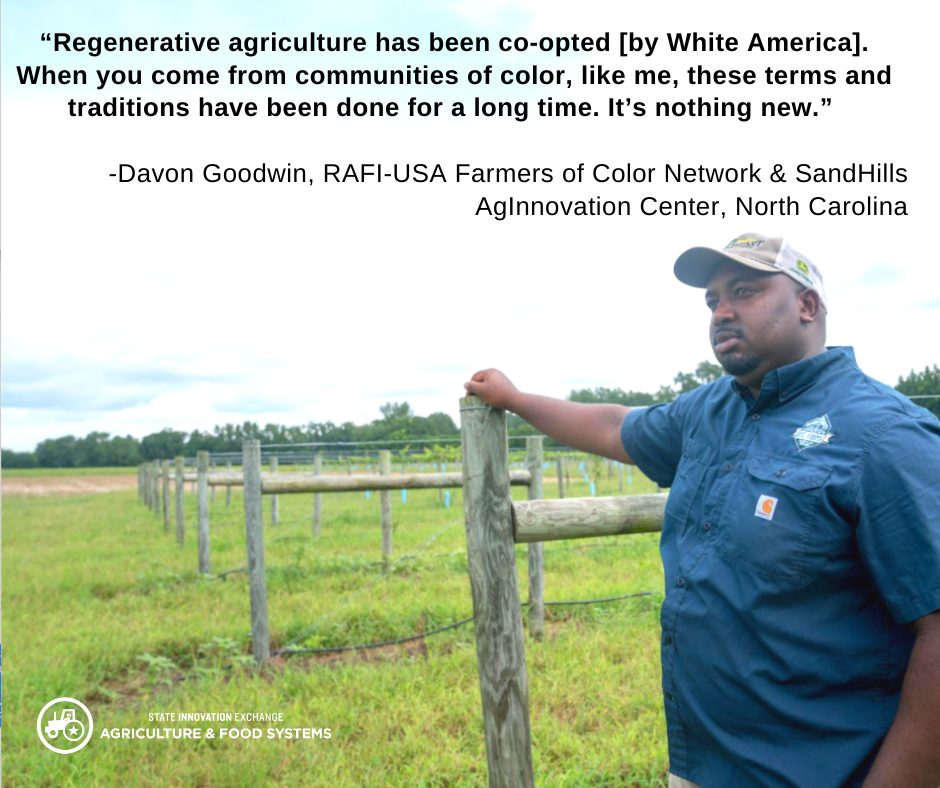As the climate crisis worsens, state legislators are looking to policy as a solution to climate change’s impacts on our food system and communities. As more constituents become aware of the importance of healthy soil in the fight against climate change, legislators are increasingly looking to implement agriculture policies that incentivize healthy soil and regenerative agriculture practices.
It’s Not New.
Regenerative agriculture is not a “new” innovation, says Davon Goodwin of RAFI-USA’s Farmer of Color Network and SandHills AgInnovation Center in North Carolina. “Regenerative agriculture has been co-opted [by White America]. When you come from communities of color these terms and traditions have been done for a long time. It’s nothing new.”
But today’s regenerative agriculture policy often doesn’t reflect that long history of knowledge and tradition, and in some cases, it hinders the climate-friendly practices that Indigenous and Black farmers have been doing for generations.
“We still practice our indigenous way of raising strawberries. We let the weeds grow up in them and let the animals tamp them down, then we spread the compost.” says Millard Locklear, a seventh generation Indigenous farmer and member of RAFI-USA’s Farmer of Color Network.
But Millard’s practices are often interrupted by agriculture policy. He’s not able to use compost in a traditional manner due to regulations that require compost to be a certain number of days old. “It’s just driving our cost up through the regulations they are putting on us,” he says.
Davon sees it as a problem of communication with legislators and an overall lack of understanding of the deep knowledge and climate-friendly practices employed by communities of color. “When I look at the co-opting of our culture… we get no credit for these practices that we’ve been doing since the beginning. When White America gets these practices it’s like the greatest thing ever,” he says. “If you let [our] voices come to the table, [we] could solve a lot of problems.”

Healthy Soil Policy is Moving.
Many legislators and advocates are beginning to listen. With the dangerous impacts of the climate crisis accelerating and the increasing awareness of the historical and ongoing racism experienced by farmers of color, legislators are looking to center farmers of color’s voices and prioritize equity in creating climate-friendly agriculture policy.
In Minnesota, HF 701, a soil health bill centers race and equity through a tiered approach to accessing grants and resources. Minnesota is a state where there are a number of emerging farmers of color, new immigrant farmers, and farmers who have been historically marginalized entering agriculture through the local foods community.
In Hawaii, SD 1410 would assure the right of native Hawaiian cultural practitioners to engage in customary and traditional subsistence farming. And a Senate Resolution in Hawaii, SR 185, would secure the right of Native Hawaiian communities to participate in the state’s coastal planning and management process to protect ecologically fragile coastline habitat using traditional practices.
New Mexico passed a NM Health Soil Act in 2019 with significant bi-partisan support. A strategy which Robb Hirsch, Executive Director and Founder of the Climate Change Leadership Institute, says is a “winning formula.” “Our bill [HB 204] was very well received because of the listening that happened on the ground with farmers and ranchers,” Robb states.
“We emphasized principles over practices which we did because people can latch on to practices and claim they are being green. But if you focus on the principles it can be really fruitful in this space.” In the 2021 session, New Mexico legislators virtually unanimously approved HB 89 “the healthy soil tax refund contribution option” that will increase engagement with New Mexico’s healthy soil program. HB 89 was recently signed into law by Governor Grisham.

Robb celebrates the legislative wins for New Mexico’s soil.
Just the Beginning.
In Davon’s view, these policies are a great start but he emphasizes that building healthy soil doesn’t end with passing a healthy soil bill. The legislation is just the beginning and ongoing support for farmers to implement these practices is crucial, especially with farmers of color, who are resource-limited.
“When I look at agriculture policy that has been done over the years, it hasn’t addressed people of color. We’ve always been left out….with the new legislation [that centers equity and community of color voices] it’s a start of a long way to go,” says Davon.
If legislators want to create impactful climate-friendly agriculture policy, Davon encourages legislators to talk with farmers. “When I think about what it’s going to take for us to be climate resilient, it’s going to take money [like grants for farmers of color] and a lot of people listening.”
State legislators interested in connecting with farmers of color can reach out grassroots organizations working with communities across the country. RAFI-USA’s Farmer of Color Network and the Midwest Farmers of Color Collective are great places to start. Reach out to [email protected] if you need more assistance.

